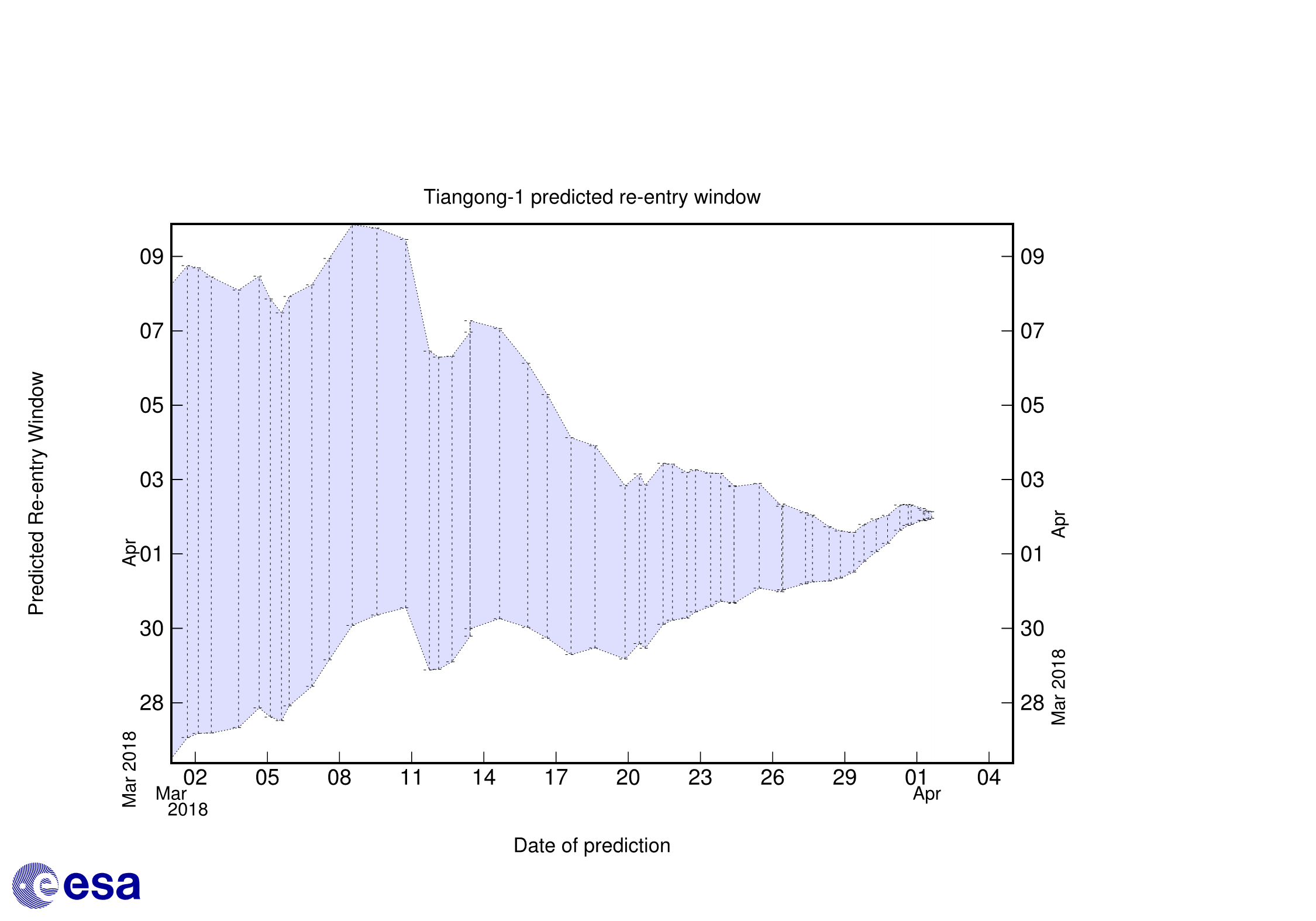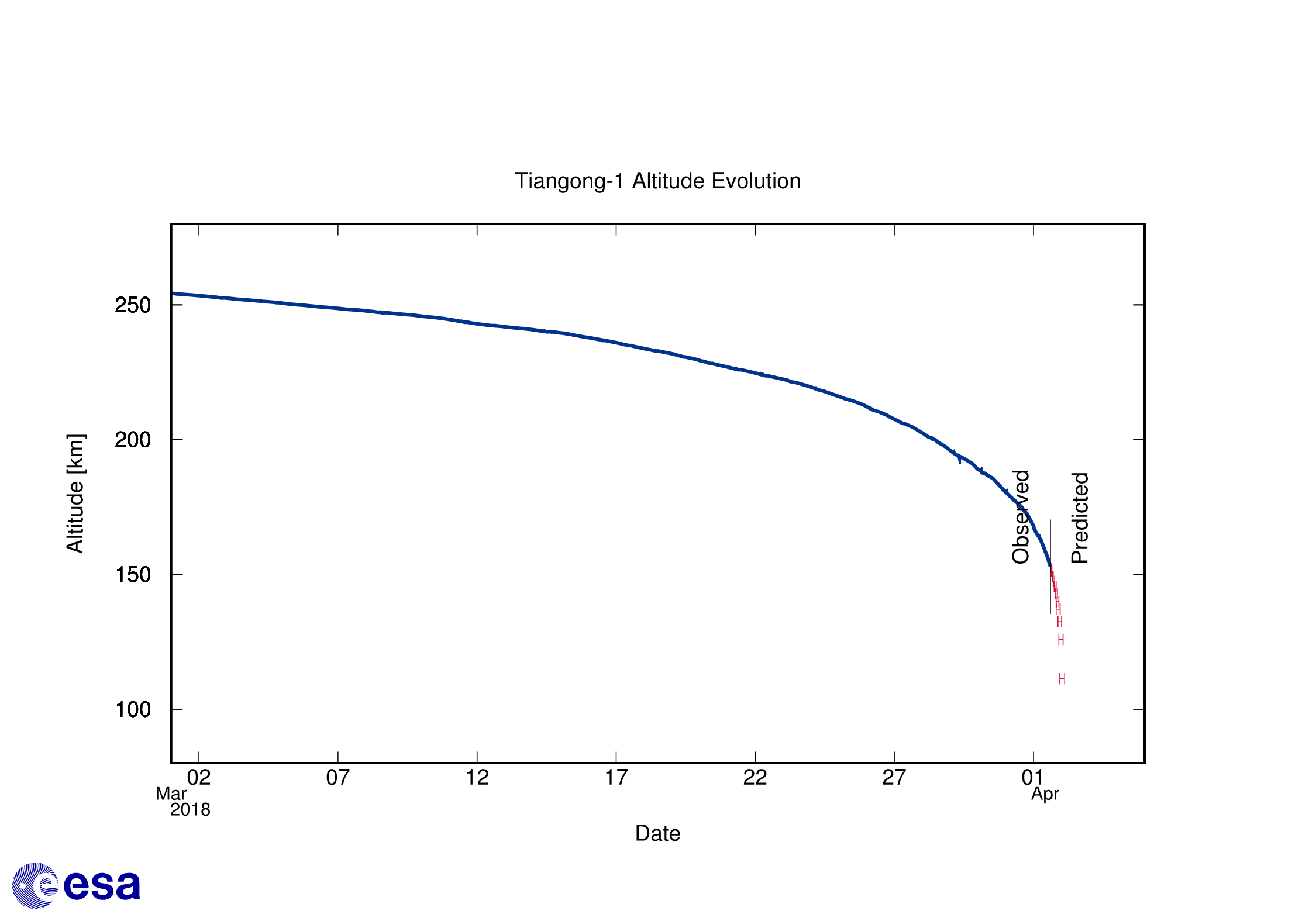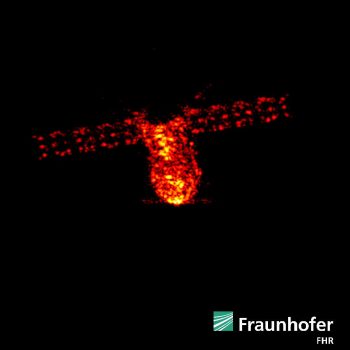Main Control Room at ESA’s European Space Operations Centre, Darmstadt, Germany. Credit: ESA/P. Shlyaev
With the reentry of Tiangong-1 now forecast to happen within a few hours, ESA’s formal role in the tracking campaign is winding down.
To recall, here’s what’s been happening.
Each year, about 100 tonnes of defunct satellites, uncontrolled spacecraft, spent upper stages and discarded items like instrument covers are dragged down by Earth’s upper atmosphere, ending their lives in flaming arcs across the sky.
While still in orbit, these and many other objects are tracked by a US military radar network, which shares the data with ESA, since Europe has no such capability of its own.
IADC campaign
Around once a year, ESA takes part in a joint tracking campaign run by the Inter Agency Space Debris Coordination Committee, which consists of experts from 13 space organisations such as NASA, Roscosmos, CNSA and European and other national agencies.
With the agreement of all members, Tiangong-1’s reentry was the mission selected for this year’s campaign.
During the campaign, participants have been pooling their predictions of the time window, as well as their respective tracking datasets obtained from radar and other sources, with the aim of cross-verifying, cross-analysing and improving the prediction accuracy for all members.
ESA has been acting as host and administrator for the campaign, as it has done for the twenty previous IADC test campaigns since 1998. A special case for ESA was the campaign in 2013 during the uncontrolled reentry of ESA’s own GOCE satellite.
The China Manned Spaceflight organisation have been providing their own updates on reentry, and additional Tiangong-1 orbit information is here.
ESA’s reentry expertise
In addition to IADC campaigns, it is the task of ESA’s Space Debris team to generate its own independent predictions to ESA Member States and partner civil authorities around the globe.
The team mix in additional tracking information gleaned from European sources, such as Germany’s Fraunhofer research radar near Bonn or telescopes and other detectors run by a mix of institutional and private researchers, to generate reentry forecasts – a challenging and imprecise art.
We’ve been posting ESA’s reentry forecasts regularly here in the blog, and sharing the link via social media.
Getting close
In just a few hours, we’ll be well within the uncertainty window associated with this reentry, and we don’t expect any more forecast updates with any higher accuracy. In other words, we’re at the limit of what we can forecast.
Just over an hour ago, ESA’s space debris team provided their final estimate for reentry, forecasting a window of about four hours and centred on 01:07 UTC (03:07 CEST) on 2 April.

Final Tiangong-1 reentry window forecast for 18:00 CEST 1 April Credit: ESA

Final Tiangong-1 altitude decay forecast as of 18:00 CEST, 1 April Credit: ESA
“With our current understanding of the dynamics of the upper atmosphere and Europe’s limited sensors, we are not able to make very precise predictions,” says Holger Krag, head of ESA’s Space Debris Office.
Holger says that there will always be an uncertainty of a few hours in all predictions, and that even just a day or so before any reentry, like now, the uncertainty window can be very large.
“The high speeds of returning satellites mean they can travel thousands of kilometres during that time window, and that makes it very hard to predict a precise location of reentry.”
Spotting reentry
It is likely that the pending reentry of Tiangong-1 will occur over water, probably unseen by anyone (although possibly detected by radar or other sensors).

Tiangong-1 seen at an altitude of about 161 km by the powerful TIRA research radar operated by the Fraunhofer Institute for High Frequency Physics and Radar Techniques (FHR) near Bonn, Germany. Image acquired on the morning of 1 April 2018, during one of the craft’s final orbits. Credit: Fraunhofer FHR
Our planet is a big place, mostly covered by water, and if any pieces survive the fiery reentry, these are unlikely to be found by anyone, sinking instead to the bottom of some ocean, or landing far from human habitation.
If you do witness the event, we’d certainly like to see any images you get.
These will help ESA’s debris team conduct their post-reentry analysis, and improve models and forecasts for future.
We need the time, your location (GPS coordinates fine) and – ideally – the direction in which you were facing when you saw any arc across the sky.
You can share your photos via Twitter (just tag @esaoperations), or mail them to esoc.communication@esa.int. We’ll reply for a confirmation and any follow-up.
In the unlikely case that you find a piece of debris on ground, leave it alone and inform your local authorities.
Our final word comes from last week’s web article, which closed with an observation worth repeating:
Since 2009, ESA has been developing software, technologies and precursor systems to test a fully European network that would provide independent data on the risks from spaceflight.
“Today, everyone in Europe relies on the US military for space debris orbit data – we lack the radar network and other detectors needed to perform independent tracking and monitoring of objects in space,” says Holger Krag.
“This is needed to allow meaningful European participation in the global efforts for space safety.”
from Rocket Science https://ift.tt/2J9eyJy
v
Main Control Room at ESA’s European Space Operations Centre, Darmstadt, Germany. Credit: ESA/P. Shlyaev
With the reentry of Tiangong-1 now forecast to happen within a few hours, ESA’s formal role in the tracking campaign is winding down.
To recall, here’s what’s been happening.
Each year, about 100 tonnes of defunct satellites, uncontrolled spacecraft, spent upper stages and discarded items like instrument covers are dragged down by Earth’s upper atmosphere, ending their lives in flaming arcs across the sky.
While still in orbit, these and many other objects are tracked by a US military radar network, which shares the data with ESA, since Europe has no such capability of its own.
IADC campaign
Around once a year, ESA takes part in a joint tracking campaign run by the Inter Agency Space Debris Coordination Committee, which consists of experts from 13 space organisations such as NASA, Roscosmos, CNSA and European and other national agencies.
With the agreement of all members, Tiangong-1’s reentry was the mission selected for this year’s campaign.
During the campaign, participants have been pooling their predictions of the time window, as well as their respective tracking datasets obtained from radar and other sources, with the aim of cross-verifying, cross-analysing and improving the prediction accuracy for all members.
ESA has been acting as host and administrator for the campaign, as it has done for the twenty previous IADC test campaigns since 1998. A special case for ESA was the campaign in 2013 during the uncontrolled reentry of ESA’s own GOCE satellite.
The China Manned Spaceflight organisation have been providing their own updates on reentry, and additional Tiangong-1 orbit information is here.
ESA’s reentry expertise
In addition to IADC campaigns, it is the task of ESA’s Space Debris team to generate its own independent predictions to ESA Member States and partner civil authorities around the globe.
The team mix in additional tracking information gleaned from European sources, such as Germany’s Fraunhofer research radar near Bonn or telescopes and other detectors run by a mix of institutional and private researchers, to generate reentry forecasts – a challenging and imprecise art.
We’ve been posting ESA’s reentry forecasts regularly here in the blog, and sharing the link via social media.
Getting close
In just a few hours, we’ll be well within the uncertainty window associated with this reentry, and we don’t expect any more forecast updates with any higher accuracy. In other words, we’re at the limit of what we can forecast.
Just over an hour ago, ESA’s space debris team provided their final estimate for reentry, forecasting a window of about four hours and centred on 01:07 UTC (03:07 CEST) on 2 April.

Final Tiangong-1 reentry window forecast for 18:00 CEST 1 April Credit: ESA

Final Tiangong-1 altitude decay forecast as of 18:00 CEST, 1 April Credit: ESA
“With our current understanding of the dynamics of the upper atmosphere and Europe’s limited sensors, we are not able to make very precise predictions,” says Holger Krag, head of ESA’s Space Debris Office.
Holger says that there will always be an uncertainty of a few hours in all predictions, and that even just a day or so before any reentry, like now, the uncertainty window can be very large.
“The high speeds of returning satellites mean they can travel thousands of kilometres during that time window, and that makes it very hard to predict a precise location of reentry.”
Spotting reentry
It is likely that the pending reentry of Tiangong-1 will occur over water, probably unseen by anyone (although possibly detected by radar or other sensors).

Tiangong-1 seen at an altitude of about 161 km by the powerful TIRA research radar operated by the Fraunhofer Institute for High Frequency Physics and Radar Techniques (FHR) near Bonn, Germany. Image acquired on the morning of 1 April 2018, during one of the craft’s final orbits. Credit: Fraunhofer FHR
Our planet is a big place, mostly covered by water, and if any pieces survive the fiery reentry, these are unlikely to be found by anyone, sinking instead to the bottom of some ocean, or landing far from human habitation.
If you do witness the event, we’d certainly like to see any images you get.
These will help ESA’s debris team conduct their post-reentry analysis, and improve models and forecasts for future.
We need the time, your location (GPS coordinates fine) and – ideally – the direction in which you were facing when you saw any arc across the sky.
You can share your photos via Twitter (just tag @esaoperations), or mail them to esoc.communication@esa.int. We’ll reply for a confirmation and any follow-up.
In the unlikely case that you find a piece of debris on ground, leave it alone and inform your local authorities.
Our final word comes from last week’s web article, which closed with an observation worth repeating:
Since 2009, ESA has been developing software, technologies and precursor systems to test a fully European network that would provide independent data on the risks from spaceflight.
“Today, everyone in Europe relies on the US military for space debris orbit data – we lack the radar network and other detectors needed to perform independent tracking and monitoring of objects in space,” says Holger Krag.
“This is needed to allow meaningful European participation in the global efforts for space safety.”
from Rocket Science https://ift.tt/2J9eyJy
v

Aucun commentaire:
Enregistrer un commentaire